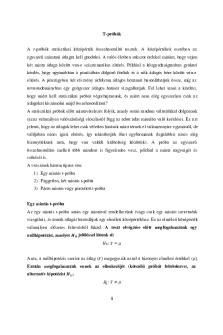GDand T reference chart PDF

| Title | GDand T reference chart |
|---|---|
| Course | Engineering Concepts |
| Institution | Brunel University London |
| Pages | 1 |
| File Size | 92.9 KB |
| File Type | |
| Total Downloads | 71 |
| Total Views | 145 |
Summary
Download GDand T reference chart PDF
Description
GD&T REFERENCE GUIDE SYMBOL
NAME
FOR SURFACE TOLERANCE ZONE OR F.O.S.? SHAPE (see below)
CAN USE MMC OR LMC MODIFIER?
CREATES VIRTUAL CONDITION?
DATUM REF?
Straightness
Either
a, b, c
Yes, if a F.O.S.
Never
Yes, if on F.O.S.
Flatness
Either
b
Yes, if a F.O.S.
Never
Yes, if on F.O.S.
Circularity
Surface
d
No
Never
No
Cylindricity
Surface
e
No
Never
No
Profile of a Line
Surface
a, d, f
No*
Usually
No
Profile of a Surface
Surface
b, e, g
No*
Usually
No
Parallelism
Either
a, b, c
Yes, if a F.O.S.
Always
Yes, if on F.O.S.
Perpendicularity
Either
a, b, c
Yes, if a F.O.S.
Always
Yes, if on F.O.S.
Angularity
Either
a, b, c
Yes, if a F.O.S.
Always
Yes, if on F.O.S.
Position
F.O.S.
b, c, h
Yes
Always †
Yes
Concentricity
F.O.S.
c
No
Always
Yes
Symmetry
F.O.S.
b
No
Always
Yes
Circular Runout
Surface
d
No
Always
Yes**
Total Runout
Surface
e
No
Always
Yes**
Form controls
Profile controls
Orientation controls
Location controls
Runout controls
a = 2 parallel lines
b = 2 parallel planes
e = 2 coaxial cylinders
c = cylinder
d = 2 coaxial circles
f = 2 irregular line boundaries
g = 2 irregular surface boundaries
h = sphere
*The datum reference(s) may use MMC or LMC modifiers, if a F.O.S. datum †
Exception: position applied to coaxial holes
**It is not a true "virtual condition" as defined in the standard, but it does create a "worst-case boundary" that may be important for assembly or function.
F.O.S. stands for “feature of size” (a pin, hole, slot, etc.)
Helpful things to remember:
The current standard for GD&T is ASME Y14.5-2009, from the American Society of Mechanical Engineers. It replaces the 1994 version. The rectangular box that contains a GD&T callout is known as the "feature control frame." A geometric tolerance shown in a feature control frame is always total, not plus/minus. Depending on how it is used, it may be centered around a fixed location, or it may float within a given size limit. The datum references (the letters at the end of a feature control frame) are given in a specific order to show the relative importance of each (primary, secondary, and tertiary).They do not have to be in alphabetical order, but rather order of precedence. The modifier M is helpful for clearance fits. It allows the tolerance to increase as the size of the feature varies. It can also be used on datum references if there might be looseness or "play" on those features. Datum features should be identified on physical items (surface, hole, pin, etc.) not on an imaginary center line. Even if the true datum might be a center, the symbol should still appear on the feature from which the center is derived. Basic dimensions (boxed dimensions) do not have any direct tolerance. Instead, they are indirectly toleranced from a feature control frame. Basic dimensions are most common in conjunction with position and profile controls. Concentricity is expensive to inspect. Often, position or runout can be used to achieve the same goal. (Reason: concentricity measures the centers of every cross-section, but position measures the center of an envelope, and runout measures the physical surface.) One of the most powerful GD&T symbols is profile of a surface. It controls a shape (which is defined by basic dimensions) by building a three-dimensional tolerance zone around it. And depending on how it relates to the datums, it can also control orientation and location. Modifiers to know:
M = maximum material condition P = projected tolerance zone
©2009 Geometric Learning Systems
L = least material condition U = unequal tolerance zone
F = free state T = tangent plane www.gdtseminars.com...
Similar Free PDFs

GDand T reference chart
- 1 Pages

GDand T reference chart
- 1 Pages

Caso Focus con T-chart
- 2 Pages

T groups - t group
- 3 Pages

Anesthesia Chart Chart
- 7 Pages

T-próba - t-próba
- 15 Pages

Reference List
- 4 Pages

L01 - reference
- 36 Pages

Reference assignment
- 2 Pages

reference guide
- 2 Pages

Reference Guide
- 6 Pages

Reconstitution - reference
- 14 Pages
Popular Institutions
- Tinajero National High School - Annex
- Politeknik Caltex Riau
- Yokohama City University
- SGT University
- University of Al-Qadisiyah
- Divine Word College of Vigan
- Techniek College Rotterdam
- Universidade de Santiago
- Universiti Teknologi MARA Cawangan Johor Kampus Pasir Gudang
- Poltekkes Kemenkes Yogyakarta
- Baguio City National High School
- Colegio san marcos
- preparatoria uno
- Centro de Bachillerato Tecnológico Industrial y de Servicios No. 107
- Dalian Maritime University
- Quang Trung Secondary School
- Colegio Tecnológico en Informática
- Corporación Regional de Educación Superior
- Grupo CEDVA
- Dar Al Uloom University
- Centro de Estudios Preuniversitarios de la Universidad Nacional de Ingeniería
- 上智大学
- Aakash International School, Nuna Majara
- San Felipe Neri Catholic School
- Kang Chiao International School - New Taipei City
- Misamis Occidental National High School
- Institución Educativa Escuela Normal Juan Ladrilleros
- Kolehiyo ng Pantukan
- Batanes State College
- Instituto Continental
- Sekolah Menengah Kejuruan Kesehatan Kaltara (Tarakan)
- Colegio de La Inmaculada Concepcion - Cebu



